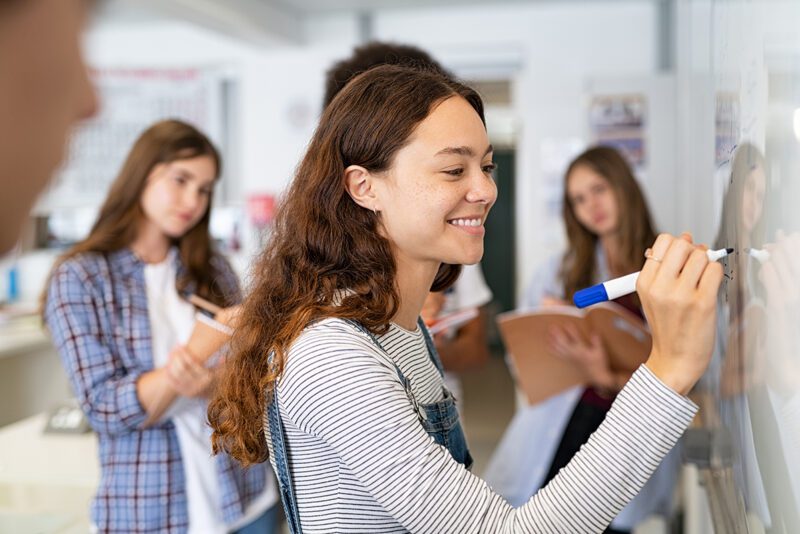Creating independent learners with an innovative revision programme
Exam students are regularly shown techniques for how to revise efficiently. All subject teachers give their classes their own recipe for successful exam preparation, from revisiting topics to making flash cards, carefully planning a balanced revision schedule and going through past papers, or even using the Pomodoro technique. Yet when it comes to study leave, there are still students who feel left in the lurch. Without the right support, their planning can fail from the first day and their mood can swing between working 24/7 and wanting to give up.
As a Head of Year, I have often wondered where we could have been going wrong. How can we as teachers support students in making their revision process more efficient? How can we help them to differentiate their own needs; ensure their exam preparation is thorough and yet balanced to avoid burn-out; reduce their anxiety whilst also keeping their stamina up?
The pandemic has had a deep impact on education. Although it has thrown a lot of complications into both students’ and teachers’ lives, it has at the same time freed creativity and enabled out-of-the-box thinking to flourish. This year, our school camps were cancelled and replaced by ‘School Without Walls’ days. My pastoral team and some innovative colleagues decided to launch our first in-school exam preparation programme, and in this post I will walk you through exactly what we did.
Using strategies from Dr. Todd Handy, a UBC professor in the Department of Psychology specialised in cognitive neuroscience and Laurie Santos, Professor of Psychology and Director of the Comparative Cognition Laboratory and the Canine Cognition Center at Yale University, we developed a sequence of active learning sessions combined with creative and relaxation sessions.
Space it out, don’t do it all at once
We started by using some key research from neuroscience:
“The brain is more effective at absorbing and retaining information if you have multiple, shorter study sessions than if you cram everything in all at once.”
Dr T. Handy, Professor in the UBC Department of Psychology
Revision sessions were thus scattered across the day around activities that would enable students’ brains to go through a “consolidation process”. We scrapped the normal timetable, instead giving students the opportunity to choose their sessions every morning and we were flexible with last-minute changes.
Test students in the same way they will be tested in the exam
Study would preferably be, wherever possible, screen-free and active. Prior to the revision week, students watched numerous talks about how re-reading notes and assignments was not a sufficient strategy for exam preparation. We wanted them to experience the feeling of “retrieving” their knowledge, and “embracing difficulties” such as dealing with a random order of questions, identifying “the illusions of knowing” and thus “making it stick”. (For more details, I would recommend the book “Make It Stick: The Science of Successful Learning“).
Students had to not only dive in with past papers or exam questions but they had to time themselves and reflect on their exam skills. Some also timed their attention span and developed strategies to pace themselves in exam conditions and thus avoid silly mistakes that can arise when the mind starts wandering. Teachers ensured that strict silence was maintained and support for questions was provided at the end of the session. Those sessions were intense, so they needed to be no longer than two hours and counter-balanced with activities that would activate the other part of their brain.
Allow them to unwind and develop their non-academic skills
Their consolidation time was primarily aimed at boosting their wellbeing. They needed to shift from developing resilience strategies to help them deal with all the things that could go wrong in their exams, to instead celebrating all the ‘feel-good’ things in life. We therefore decided to build a choice of activities that would enable them to use some of their character strengths, do some exercise and practise ‘savouring’ the things that they enjoy.
We offered students a wide range of activities such as board games, indoor and outdoor sports (e.g. badminton, table tennis, basketball, volleyball, swimming), a MasterChef challenge a day and a wood-carving activity. The teacher–student relationship was blurred and replaced by a complete spirit of collaboration. The atmosphere was light, and everybody easily switched from tense revision mode to laughing, singing and dancing. The fairly broad choice of activities enabled everybody to shine away from their academic skills. Cooking was definitely a hit; students’ curries, mixed salads, bibimbap and fresh juice appealed to everybody’s senses. Their smells, colours, textures and tastes further added to the vibrant atmosphere. Some students even realised it was the end of an era and felt nostalgic. It was a great time to experience ‘savouring’, i.e. taking the time to cherish and reflect on the things they enjoy. The cherry on the cake was that there was way too much food, so students experienced performing an ‘act of kindness’ by sharing their creation with the school community and preparing takeaway portions for the homeless.
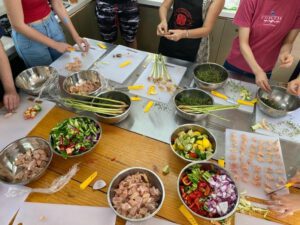 |
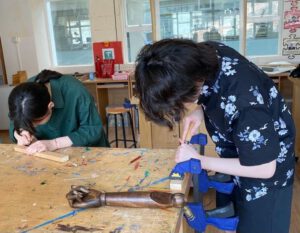 |
Projecting themselves in the future and making a legacy
The final aim for our graduates was to project themselves in the future. We of course took time to concentrate on mental exam preparation. To guide them towards becoming mentally prepared, we used daily short guided meditations and a technique called WOOPing. The aim was to lead them to visualise themselves in a difficult situation and plan ways to overcome possible obstacles.
We were pleasantly surprised to see that more students than usual truly tried their best and engaged. We also reminded them of the importance of sleep and mental rest, discussing how a few minutes’ guided meditation could support them in reducing their anxiety, clearing their minds and creating a calm mood which would boost concentration and increase their working memory capacity.
As we wanted them to feel like full-grown adults, we suggested they should leave a legacy for the future generation. They came up with the idea of starting the new tradition of planting a tree with their year cohort engraved in the trunk and to paint a mural. A handful of students came up with the design and the rest of the cohort went to paint the mural when they needed a break from their revision.
Finally, we had them complete their CV and cover letter and set up their LinkedIn account to create their grade alumni network.
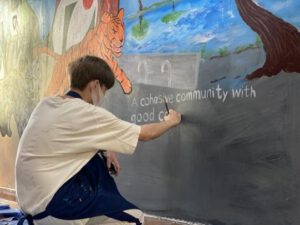 |
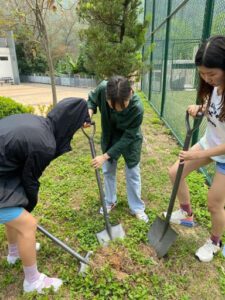 |
How can I apply all of this in my school remotely?
| Due to the pandemic, some or all of your students may be learning remotely, or you might simply not have the opportunity to do “days without walls”. With a strong online community, the technique can of course still be applied remotely. Students can take part in virtual creative projects, online sports challenges, guided meditation, building their LinkedIn accounts or creating an e-legacy. Teachers don’t necessarily need to be always online or run the activities, they simply need to help pace the day for the whole cohort. You can also try to make students accountable for their work by posting their screen statistics to a group forum. An app like Kronos timekeeper is a great tool for reflecting and improving online time management! |
I would love to repeat the experience next year and maybe even try it with younger age groups. At a time when wellbeing, balanced life, mindfulness and sustainability are increasingly important, it is paramount to guide students to truly experience those concepts, as they can sometimes be left until it’s too late.
Do you practice any of these techniques with your exam students? If not, are there any that you will try going forward?
Blog articles

